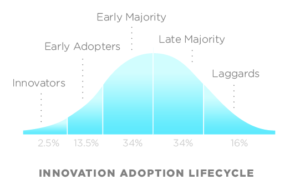How long until cryptocurrencies are widely adopted?
‘It’ll never catch on’, ‘We’ve always done it this way’, and ‘I don’t see the point’. We’ve all heard naysayers, objectors and laggards try to reject change, but fortunately for the rest of us, change is inevitable.
Have you ever heard of, or seen the Innovation Adoption Lifecycle? It’s mostly applied in the tech world, for new gadgets and apps, but it’s equally applicable to cryptocurrencies. See the graph below, and rather than try to place yourself along this graph, try and make an educated guess as to where cryptocurrency has reached in wide society. It’s hard, right?
Trust
For cryptocurrencies to be widely adopted and accepted, they must first be trusted. How do they build trust? Well, positive experience and word of mouth is one way, but really the trust and adoption will almost correlate exactly. As more outlets become available for engaging different currencies, more people will start using them, and vice versa, as more people start using the currencies, more outlets will appear.
Wide adoption will come when everybody is using cryptocurrencies, but with objectors in the ranks, the only way to achieve this is to apply a system in which people don’t even realise they are using them. Then, we may face the issue in which people lose trust, because they feel that they are involuntarily using cryptocurrencies because of ‘the system’.
Much like any system, perfect trust and terms of use may never exist, though, if cryptocurrency can position itself right, it may win ultimate trust by virtue of doing a better job of banking than… banks. As an additional bonus, if a cryptocurrency fails, it’s not taxpayers’ money that will bail it out.
Avoiding central governments is a good thing because of currency manipulation
Central governments have been trading on the foreign exchange market for a long time, buying and selling their own currency in order to achieve a number of goals, such as controlling inflation, being competitive against rival currencies and achieving financial stability.
We don’t know about you, but generally, nobody likes to play a game where the house always wins. Since cryptocurrencies are decentralised, it’s a fair game across the board, with no governments interfering with values and movements.
Central governments also like to do something called ‘quantitative easing’, in which they print more money and inject it into the economy when it’s being sluggish, to act as a stimulant. It doesn’t always work, as it initially pushes down the price of the dollar.
With cryptocurrencies, miners are able to help process transactions in order to earn pieces of the currency, and this is how the circulating supply increases. The owners or designers of the currencies cannot simply invent new coins to throw into the marketplace, as this would be fraudulent. Some cryptocurrencies are capped forever, without the potential for mining, such as Ripple, IOTA, NEO and EOS.
Historical currency changes
Let’s bypass cattle, crop, human, and resource trading and start with actual coins. Between the Mesopotamians and the Babylonians, both currency, and the concept of debt, property, compensation and business really became a necessity.
After more than 3,000 years of refining the process of metal coins, the Chinese Song Dynasty began using paper to assign values to currency in the 7th century on a local scale, before it becomes more widely adopted in the 11th century. By the 12th century, there was 26 million times more paper currency being printed than coins being produced each year.
It took until the 16th century in London for paper currency to become widely used, with various goldsmiths accepting gold in exchange for their paper values. The paper ‘promissory notes’ that were given out started to be exchanged themselves, rather than collecting the gold and trading that.
The system was flawed from day one, as the integrity of the goldsmiths, who became banks, and how well known they were, directly related to how likely a promissory note would be accepted. In 1694, more than 100 years later, the government took over and were granted the sole right to issue currency.
Much later, credit cards were introduced by American Express and the Bank of America in 1958, in California. It took a long time for credit and debit cards to really catch on, and even today, in the first world, it’s quite normal to find shops, cafes and restaurants who don’t accept this form of payment. Talk about laggards!
How long until the mainstream adoption of crypto?
There are three major indications that crypto is being widely adopted; the rise in value due to the rise in demand, the attempts of central governments to reduce the dependence on cash and increase the emphasis on credit and debit cards, and the emergence of new ways to apply cryptocurrencies.
In India in the summer of 2017, the government banned the 500 (£5.80) and 1,000 rupee notes overnight in an attempt to tackle cash hoarders. It was a spectacular failure, causing panic, unrest, and 99% of the newly illegal money ending up back in the banks anyway. For a country that mostly works on a cash basis, the people simply weren’t ready for this.
In 2015, the state of Louisiana tried to ban cash transactions between citizens, before it was deemed unconstitutional and thrown out. In the end, a law was passed banned the cash purchase of precious metals, like gold and silver. With some governments seeing cash as a threat, it’s only natural to see them pushing people towards a more digital system.
“Cryptocurrencies rise in value because they are being adopted, not because they rise in value”.
The rise in demand comes from various sources, such as the widespread popularity and discussion on social media, official government comments, airtime on news channels and the increasing accessibility of entry to the market (through platforms like Coinbase).
Our third reason that will affect how long widespread adoption takes, is how quickly big businesses start accepting cryptocurrencies. Microsoft and PayPal were early adopters of bitcoin payments (and donations), as were Dell, Steam, Save the Children, Wikipedia and Tesla.
Transaction fees make small transactions, like buying a cup of coffee, very inefficient with currencies like Bitcoin and Ethereum. Cryptocurrency IOTA, which does not exist on the blockchain, is one option for feeless transactions and could be a major player in encouraging widespread adoption.
Bitcoin ATMs
In the UK, there are almost 90 Bitcoin ATMs, which allow you to buy bitcoins physically with cash, input a bitcoin wallet address, and credit your account all in one transaction. Some of these machines allow you to sell your bitcoin and withdraw cash too. Whilst this concept is yet to blow up and take off massively, it is a great indication of what’s to come when Bitcoin is fully adopted.
Conclusion
Who better to conclude this piece than Andreas Antonopoulos, author or ‘Mastering Bitcoin’ and ‘The Internet of Money’. In October 2016, at a Bitcoin meetup in Germany, he said: “How long until mainstream adoption? Previous revolutions in money. In the mid-90s, you still couldn’t pay with a credit card in many places. I predict it will take 15-20 years for mainstream adoption of Bitcoin. We are in a race because governments around the world are trying to ban cash and force us to adopt a different sort of digital currency with complete surveillance, where they can flip and switch and you will no longer exist as a person if you doing anything they consider radical. Adoption patterns and the Gini coefficient. The ownership of Bitcoin is not as diverse as it should be, primarily because of the way it grew. But people who got in early and took the risk have been enormously rewarded; no one’s coming to bail out Bitcoin.”




